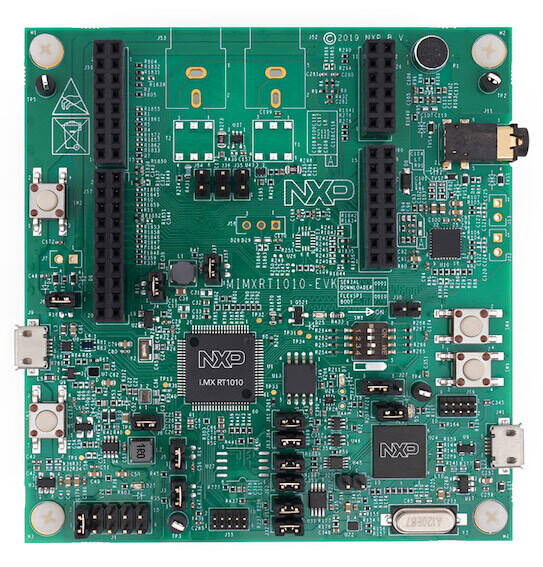NXP MIMXRT1010-EVK
Overview
The i.MX RT1010 offer a new entry-point into the i.MX RT crossover processor series by providing the lowest-cost LQFP package option, combined with the high performance and ease-of-use known throughout the entire i.MX RT series. This device is fully supported by NXP’s MCUXpresso Software and Tools.

Hardware
MIMXRT1011DAE5A MCU
Memory
128 Mbit QSPI Flash
Connectivity
Micro USB host and OTG connectors
Arduino interface
Audio
Audio Codec
4-pole audio headphone jack
External speaker connection
Microphone
Debug
JTAG 10-pin connector
OpenSDA with DAPLink
For more information about the MIMXRT1010 SoC and MIMXRT1010-EVK board, see these references:
External Memory
This platform has the following external memories:
Device |
Controller |
Status |
|---|---|---|
AT25SF128A |
FLEXSPI |
Enabled via flash configurationn block, which sets up FLEXSPI at boot time. |
Supported Features
The mimxrt1010_evk board configuration supports the hardware features listed below. For additional features not yet supported, please also refer to the NXP MIMXRT1064-EVK , which is the superset board in NXP’s i.MX RT10xx family. NXP prioritizes enabling the superset board with NXP’s Full Platform Support for Zephyr. Therefore, the mimxrt1064_evk board may have additional features already supported, which can also be re-used on this mimxrt1010_evk board:
Interface |
Controller |
Driver/Component |
|---|---|---|
NVIC |
on-chip |
nested vector interrupt controller |
SYSTICK |
on-chip |
systick |
GPIO |
on-chip |
gpio |
SPI |
on-chip |
spi |
I2C |
on-chip |
i2c |
UART |
on-chip |
serial port-polling; serial port-interrupt |
USB |
on-chip |
USB device |
ADC |
on-chip |
adc |
GPT |
on-chip |
gpt |
TRNG |
on-chip |
entropy |
PIT |
on-chip |
pit |
The default configuration can be found in boards/nxp/mimxrt1010_evk/mimxrt1010_evk_defconfig
Other hardware features are not currently supported by the port.
Connections and I/Os
The MIMXRT1010 SoC has five pairs of pinmux/gpio controllers.
Name |
Function |
Usage |
|---|---|---|
GPIO_11 |
GPIO |
LED |
GPIO_SD_05 |
GPIO |
SW4 |
GPIO_10 |
LPUART1_TX |
UART Console |
GPIO_09 |
LPUART1_RX |
UART Console |
GPIO_01 |
LPI2C1_SDA |
I2C SDA |
GPIO_02 |
LPI2C1_CLK |
I2C SCL |
GPIO_AD_03 |
LPSPI1_SDI |
SPI |
GPIO_AD_04 |
LPSPI1_SDO |
SPI |
GPIO_AD_05 |
LPSPI1_PCS0 |
SPI |
GPIO_AD_06 |
LPSPI1_SCK |
SPI |
GPIO_AD_01 |
ADC |
ADC1 Channel 1 |
GPIO_AD_02 |
ADC |
ADC1 Channel 2 |
System Clock
The MIMXRT1010 SoC is configured to use SysTick as the system clock source, running at 500MHz.
When power management is enabled, the 32 KHz low frequency oscillator on the board will be used as a source for the GPT timer to generate a system clock. This clock enables lower power states, at the cost of reduced resolution
Serial Port
The MIMXRT1010 SoC has four UARTs. LPUART1 is configured for the console,
and the remaining are not used.
Programming and Debugging
This board supports 3 debug host tools. Please install your preferred host tool, then follow the instructions in Configuring a Debug Probe to configure the board appropriately.
LinkServer Debug Host Tools (Default, Supported by NXP)
J-Link Debug Host Tools (Supported by NXP)
pyOCD Debug Host Tools (Not supported by NXP)
Once the host tool and board are configured, build and flash applications as usual (see Building an Application and Run an Application for more details).
Configuring a Debug Probe
For the RT1010, J61/J62 are the SWD isolation jumpers, J22 is the DFU mode jumper, and J16 is the 10 pin JTAG/SWD header.
A debug probe is used for both flashing and debugging the board. This board has an LPC-LINK2 Onboard Debug Probe. The default firmware present on this probe is the LPC-Link2 DAPLink Onboard Debug Probe.
Based on the host tool installed, please use the following instructions to setup your debug probe:
LinkServer Debug Host Tools: Using CMSIS-DAP with LPC-Link2 Probe
pyOCD Debug Host Tools: Using CMSIS-DAP with LPC-Link2 Probe
Using CMSIS-DAP with LPC-Link2 Probe
Follow the instructions provided at LPC-LINK2 CMSIS DAP Onboard Debug Probe to reprogram the default debug probe firmware on this board.
Ensure the SWD isolation jumpers are populated
Using J-Link with LPC-Link2 Probe
There are two options: the onboard debug circuit can be updated with Segger J-Link firmware, or a J-Link External Debug Probe can be attached to the EVK.
To update the onboard debug circuit, please do the following:
Switch the power source for the EVK to a different source than the debug USB, as the J-Link firmware does not power the EVK via the debug USB.
Follow the instructions provided at LPC-Link2 J-Link Onboard Debug Probe to reprogram the default debug probe firmware on this board.
Ensure the SWD isolation jumpers are populated.
To attach an external J-Link probe, ensure the SWD isolation jumpers are removed, then connect the probe to the external JTAG/SWD header
Configuring a Console
Regardless of your choice in debug probe, we will use the OpenSDA microcontroller as a usb-to-serial adapter for the serial console. Check that jumpers J31 and J32 are on (they are on by default when boards ship from the factory) to connect UART signals to the OpenSDA microcontroller.
Connect a USB cable from your PC to J41.
Use the following settings with your serial terminal of choice (minicom, putty, etc.):
Speed: 115200
Data: 8 bits
Parity: None
Stop bits: 1
Flashing
Here is an example for the Hello World application.
# From the root of the zephyr repository
west build -b mimxrt1010_evk samples/hello_world
west flash
Open a serial terminal, reset the board (press the SW9 button), and you should see the following message in the terminal:
Hello World! mimxrt1010_evk